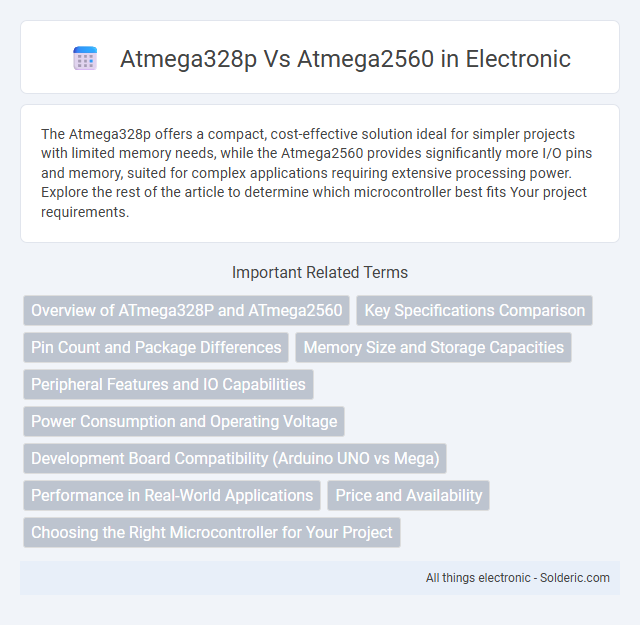The Atmega328p offers a compact, cost-effective solution ideal for simpler projects with limited memory needs, while the Atmega2560 provides significantly more I/O pins and memory, suited for complex applications requiring extensive processing power. Explore the rest of the article to determine which microcontroller best fits Your project requirements.
Comparison Table
| Feature | Atmega328p | Atmega2560 |
|---|---|---|
| Microcontroller Type | 8-bit AVR | 8-bit AVR |
| Flash Memory | 32 KB | 256 KB |
| SRAM | 2 KB | 8 KB |
| EEPROM | 1 KB | 4 KB |
| Max Clock Speed | 20 MHz | 16 MHz |
| Digital I/O Pins | 23 | 54 |
| PWM Channels | 6 | 15 |
| ADC Channels | 6 (10-bit) | 16 (10-bit) |
| USART | 1 | 4 |
| SPI | 1 | 1 |
| I2C (TWI) Channels | 1 | 1 |
| Timer/Counters | 3 (2x 8-bit, 1x 16-bit) | 6 (4x 16-bit, 2x 8-bit) |
| Operating Voltage | 1.8V - 5.5V | 4.5V - 5.5V |
| Package | 28-pin DIP, TQFP, MLF | 100-pin TQFP, BGA |
| Typical Applications | Simple embedded systems, Arduino Uno | Complex projects, Arduino Mega |
Overview of ATmega328P and ATmega2560
The ATmega328P is an 8-bit AVR microcontroller featuring 32KB of flash memory, 2KB of SRAM, and 23 general-purpose I/O pins, making it ideal for compact Arduino Uno projects. The ATmega2560, also an 8-bit AVR microcontroller, offers a larger memory footprint with 256KB of flash, 8KB of SRAM, and 86 I/O pins, suited for complex Arduino Mega applications requiring extensive input/output capabilities. Both microcontrollers operate at 16 MHz and support SPI, I2C, and UART communication protocols, but the ATmega2560 provides enhanced performance and scalability for advanced embedded systems.
Key Specifications Comparison
The Atmega328p features 32KB of flash memory, 2KB of SRAM, and operates at 20MHz, making it ideal for compact, low-power projects. In contrast, the Atmega2560 offers 256KB of flash memory, 8KB of SRAM, and a 16MHz clock speed, supporting more complex applications with extensive I/O capabilities, including 86 digital I/O pins versus 23 on the Atmega328p. Both microcontrollers are based on the AVR architecture but differ significantly in memory capacity, processing power, and peripheral options, catering to varied project requirements.
Pin Count and Package Differences
The Atmega328p features 28 pins in a compact Dual Inline Package (DIP) or TQFP format, optimizing space for smaller projects, while the Atmega2560 offers 100 pins in a larger TQFP or BGA package, supporting complex designs with numerous I/O requirements. Your choice depends on the needed pin count and physical size constraints, with the Atmega2560 excelling in applications requiring extensive connectivity and the Atmega328p favoring simplicity and ease of integration. Understanding these package and pin count differences ensures optimal hardware compatibility and design efficiency.
Memory Size and Storage Capacities
The ATmega328P features 32KB of flash memory and 2KB of SRAM, suitable for moderate-sized applications requiring efficient code storage. In contrast, the ATmega2560 offers significantly larger resources with 256KB of flash memory and 8KB of SRAM, enabling more complex projects and extensive codebases. Both microcontrollers provide EEPROM memory, with 1KB on the ATmega328P and 4KB on the ATmega2560, allowing persistent data storage essential for embedded systems.
Peripheral Features and IO Capabilities
The Atmega328p offers 23 programmable I/O pins, including support for SPI, I2C, and UART interfaces, making it suitable for moderate peripheral control tasks. The Atmega2560 significantly expands this with 54 programmable I/O pins and multiple UART ports, SPI, and I2C channels, enabling more complex device interfacing and parallel peripheral operations. Your choice between these microcontrollers should consider the scale and complexity of required peripheral interactions and I/O demands.
Power Consumption and Operating Voltage
The Atmega328p operates within a voltage range of 1.8V to 5.5V and typically consumes around 1.8 mA at 8 MHz, making it suitable for low-power projects. The Atmega2560 supports 4.5V to 5.5V and generally draws higher current, approximately 4 mA at 16 MHz, reflecting its increased processing capabilities. Your choice between these microcontrollers should consider power consumption needs and operating voltage compatibility with your hardware setup.
Development Board Compatibility (Arduino UNO vs Mega)
The Atmega328p powers the Arduino UNO development board, offering 32KB of flash memory and 2KB of SRAM, ideal for simpler projects requiring fewer I/O pins. In contrast, the Atmega2560 is the heart of the Arduino Mega, featuring 256KB of flash memory and 8KB of SRAM, designed for complex applications requiring numerous peripherals and extensive I/O capabilities. Your choice between these microcontrollers depends on project complexity and the required compatibility with UNO or Mega development boards.
Performance in Real-World Applications
The Atmega2560 offers enhanced performance in real-world applications due to its larger memory capacity of 256KB flash and 8KB SRAM compared to the Atmega328p's 32KB flash and 2KB SRAM, enabling more complex code and better multitasking. Its 86 I/O pins versus the Atmega328p's 23 facilitate extensive peripheral interfacing, crucial for advanced robotics and IoT projects. Clocked at identical speeds up to 16 MHz, the Atmega2560's superior architecture supports more efficient handling of larger data sets and multiple simultaneous processes.
Price and Availability
The Atmega328p is generally more affordable and widely available, making it a popular choice for budget-conscious projects and beginners. In contrast, the Atmega2560, with its increased memory and I/O capabilities, typically commands a higher price and may have more limited stock, especially through mainstream distributors. Your selection depends on balancing price and availability against the need for advanced features in your application.
Choosing the Right Microcontroller for Your Project
Choosing the right microcontroller for your project depends on factors such as memory capacity, processing power, and peripheral support. The Atmega328p offers 32KB of flash memory and 1KB of RAM, making it ideal for simple applications and cost-sensitive projects. For more complex designs requiring 256KB of flash memory, 8KB of RAM, and additional I/O pins, the Atmega2560 provides enhanced performance and scalability.
Atmega328p vs Atmega2560 Infographic

 solderic.com
solderic.com